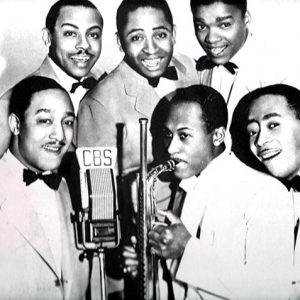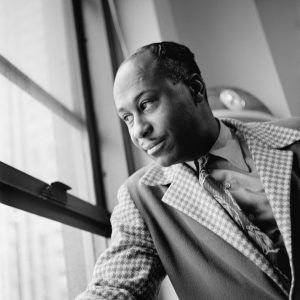calsfoundation@cals.org
Lawrence Leo "Snub" Mosley (1905–1981)
Lawrence Leo “Snub” Mosley was a jazz trombonist, composer, and band leader originally from Little Rock (Pulaski County). Nicknamed “Snub,” Mosley had a career that spanned more than fifty years, which included stints in the 1930s with Claude Hopkins, Fats Waller, and Louis Armstrong. Mosley is probably best remembered today as creator of his own unique instrument—the slide saxophone—which combined an upright saxophone and mouthpiece with a trombone mouthpiece and slide.
Snub Mosley was born on December 29, 1905, in Little Rock. Encouraged by his grandfather, he took an interest in the trombone and played in the band at M. W. Gibbs High School in Little Rock. His tendency to improvise on sheet music and (as Mosley put it) “swing” drew the ire of his band director but did bring him to the attention of Syncho Six members Eugene Crooke and Alphonso Trent, who witnessed Mosley’s trombone skills during a parade. Mosley accompanied the Syncho Six to a gig in Helena (Phillips County) and some subsequent shows, but at his mother’s insistence, he came home to graduate from high school before leaving for good. The Syncho Six—renamed the Alphonso Trent Orchestra—went on to make history in 1925 as an attraction at the Adolphus Hotel in Dallas, Texas; the band’s performances at a white hotel in an era of segregation and the band’s radio broadcasts on WFAA were firsts for an African-American band in the South.
After the Alphonso Trent Orchestra broke up in 1933, Mosley played with numerous musicians, including Claude Hopkins, Louis Armstrong, and Fats Waller before settling in New York City in 1938 and forming his own band. He achieved his greatest professional success when he performed in Ken Murray’s Blackouts variety show from 1943 to 1944, while continuing to lead his own group. On and off from 1943 through 1946, Mosley and his band toured Europe and the South Pacific with the United Service Organizations (USO), entertaining Allied troops. Mosley’s band went on a USO tour once again from 1952 to 1953, visiting Europe and the Far East.
As live bands gave way to television as America’s entertainment medium, Mosley and his fellow musicians found work harder to come by. According to music producer Frank Driggs, Mosley “was always working and was much too proud to take any type of day job. It meant though that the quality of the jobs often left a lot to be desired.” Regardless, Mosley made a living in music and split his performances between New York City and hotels in upstate New York.
As a band leader, Mosley’s biggest hit was his “The Man with the Funny Horn,” recorded with Decca in 1940, which featured his performance on the ghostly sounding slide saxophone. Following his final recording with Decca in 1942, he went on to record sessions with Sonora (1946), National (circa 1946), Avalon (also circa 1946), Penguin (1949), and Columbia (1959), as well as an entire album with United Kingdom–based Pizza in 1978, titled Live at the Pizza Express. A joyful Mosley briefly went back to Europe, this time touring as a featured artist for the Pizza label.
Toward the end of his life, Mosley suffered two debilitating strokes, one of which was further complicated by pneumonia in January 1981. He consequently moved into a nursing home in upstate New York, where he spent most of his remaining days being visited by well-wishers. Mosley died suddenly on July 21, 1981, just a few days after moving back into his apartment in New York City.
Mosley was inducted into the Arkansas Jazz Hall of Fame in 2018.
For additional information:
Carr, Ian, et al. The Rough Guide to Jazz. London: Rough Guides Ltd., 2004.
Driggs, Frank. “The Man with the Funny Little Horn…Snub Mosley.” Whiskey, Women, And…12/13 (December 1983).
Feather, Leonard, et al. The Biographical Encyclopedia of Jazz. New York: Oxford University Press, 2007.
Manskleid, Felix. “Snub Mosley.” Jazz Monthly (March 1960).
Rinne, Henry. “A Short History of the Alphonso Trent Orchestra.” Arkansas Historical Quarterly 45 (Autumn 1986): 228–249.
Wright, Laurie. “(Very) Young Man With A Horn.” Storyville 97 (October/November 1981).
Adam Miller
Georgetown, Texas

 "Snub" Mosley
"Snub" Mosley  Snub Mosley
Snub Mosley 



Comments
No comments on this entry yet.